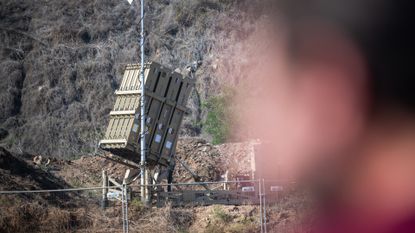How Israel's 'Iron Dome' missile defence system works
'Envy of other militaries' has 90% success rate, say Israeli officials, but US has to foot the huge cost

"We intercepted. We thwarted. Together we will win," Israel's Prime Minister Benjamin Netanyahu tweeted following Iran's missile and drone attack on Saturday.
In what one official described as "the most complex air defence events recorded", Israel claims to have shot down 99% of the 330-plus drones, cruise and ballistic missiles fired from Iran.
While Israel was assisted by US, UK, French and Jordanian forces, the success of the operation was down in large part to the country's "Iron Dome" shield – the centrepiece of one of the "best anti-missile defences in the world", said Richard Kemp in The Telegraph.
Subscribe to The Week
Escape your echo chamber. Get the facts behind the news, plus analysis from multiple perspectives.

Sign up for The Week's Free Newsletters
From our morning news briefing to a weekly Good News Newsletter, get the best of The Week delivered directly to your inbox.
From our morning news briefing to a weekly Good News Newsletter, get the best of The Week delivered directly to your inbox.
What is the Iron Dome and how does it work?
The Iron Dome is a three-piece system of interceptor batteries that shoot short-range rockets, artillery shells and mortars out of the sky. A radar tracks the missile as it is fired at Israel, and then advanced software predicts the rocket's trajectory. The information is used to guide Tamir interceptor missiles, which are fired from the ground to blow the missile into pieces in the sky.
The air defence system was built by the Israeli state-owned company Rafael Advanced Defense Systems in response to the war with Lebanon's Hezbollah in 2006, when 4,000 rockets rained down on northern Israel, killing 44 people. The Iron Dome was first used in March 2011 and made its first successful intervention the following month, when it intercepted a Grad rocket fired from Gaza.
Consisting of a series of truck-towed mobile units placed strategically throughout the country, the system, known as Kippat Barzel in Hebrew, reacts within a matter of seconds and is manned 24 hours a day. It was originally designed to protect cities and strategic sites against missiles with a range of between 2.5 and 43 miles, but is "thought to have been expanded", said Sky News.
How effective is it?
Over the past decade, the Iron Dome has proved to be "particularly effective", said Euronews. Israeli authorities claim it has a success rate of more than 90%, "although some defense analysts question those numbers", said The Washington Post.
Iron Dome quickly became the "envy of other militaries", said Sky News. It is "not perfect", however, and "has a saturation point at which it would become overwhelmed, but this exact level is unknown".
The events of 7 October 2023 – when Hamas launched more than 3,000 rockets and missiles from Gaza into Israel – seemed to test the limits of the system.
This has raised concern that Iranian proxy group Hezbollah – which is based in Lebanon and has an estimated 150,000 rockets and missiles pointing at Israel – "might launch an intensive barrage to coincide with the arrival of the weapons from Iran, in an attempt to overwhelm air defences", said Kemp in The Telegraph.
Hamas's attack, Iran's bombardment and Hezbollah's almost daily firing of rockets and drones across the border also reveal that the Iron Dome "may be effective operationally, but strategically it doesn't really deter the Palestinian organisations," Jean-Loup Samaan, a Senior Research Fellow at the University of Singapore’s Middle-East Institute, told Euronews.
How much does it cost?
Running the world's most advanced anti-missile defence shield does not come cheap. According to Samaan, just one of the interceptor Tamir missiles is estimated to cost around $50,000.
Funding was originally undertaken by Israel, "but because of the high cost of the system, the country has had to rely on its long-time ally, the United States", said Euronews.
According to the US State Department, the US has provided Israel with $3.4 billion in funding for missile defence since 2009, including $1.3 billion for Iron Dome support. Joe Biden last year requested a further $14 billion in military aid for Israel, a sizeable portion of which would go towards anti-missile defences. The support, part of a $95 billion package that includes $60 billion for Ukraine, is still being held up by Republicans in Congress.
Create an account with the same email registered to your subscription to unlock access.
Sign up for Today's Best Articles in your inbox
A free daily email with the biggest news stories of the day – and the best features from TheWeek.com
-
 Do youth curfews work?
Do youth curfews work?Today's big question Banning unaccompanied children from towns and cities is popular with some voters but is contentious politically
By Harriet Marsden, The Week UK Published
-
 'Sleaze baack!'
'Sleaze baack!'Today's Newspapers A roundup of the headlines from the US front pages
By The Week Staff Published
-
 Quiz of The Week: 20 - 26 April
Quiz of The Week: 20 - 26 AprilPuzzles and Quizzes Have you been paying attention to The Week's news?
By Rebecca Messina, The Week UK Published
-
 Will Iran attack hinder support for Ukraine?
Will Iran attack hinder support for Ukraine?Today's Big Question Pro-Kyiv allies cry 'hypocrisy' and 'double standards' even as the US readies new support package
By Elliott Goat, The Week UK Published
-
 Will Iran's attack on Israel backfire?
Will Iran's attack on Israel backfire?Today's Big Question The unprecedented targeting of Israel could be a 'godsend' for Netanyahu as the limits of Tehran's military power are exposed
By Elliott Goat, The Week UK Published
-
 Will Iran risk all-out war with Israel?
Will Iran risk all-out war with Israel?Today's Big Question Tehran has not wanted to be directly involved in the Middle East conflict so far. But that could be about to change
By Chas Newkey-Burden, The Week UK Published
-
 'Humanitarian islands': how will Israel's plan for Rafah civilians work?
'Humanitarian islands': how will Israel's plan for Rafah civilians work?Today's Big Question Designated zones in central Gaza to provide temporary housing, food and water for more than a million displaced Palestinians
By The Week UK Published
-
 What is Iran's endgame?
What is Iran's endgame?Today's Big Question Tehran seeks to supplant US and Saudi Arabia as dominant power in Middle East while forcing Israel to end Gaza war
By Harriet Marsden, The Week UK Published
-
 Israel proposes two-month pause in Gaza war in exchange for all Hamas hostages
Israel proposes two-month pause in Gaza war in exchange for all Hamas hostagesSpeed Read Deal doesn't include an agreement to end war, but might be 'the only path that could lead to a ceasefire', said US officials
By Harriet Marsden, The Week UK Published
-
 100 days of war: a timeline of the Israel-Hamas conflict
100 days of war: a timeline of the Israel-Hamas conflictThe Explainer Tens of thousands dead and Gaza in ruins as risk of wider escalation continues to grow
By The Week UK Published
-
 How Islamic State bombings in Iran could escalate regional war
How Islamic State bombings in Iran could escalate regional warThe Explainer Terrorist group claims responsibility for deadly blasts on 'irredeemable foe' but Tehran likely to ramp up anti-US rhetoric
By Harriet Marsden, The Week UK Published